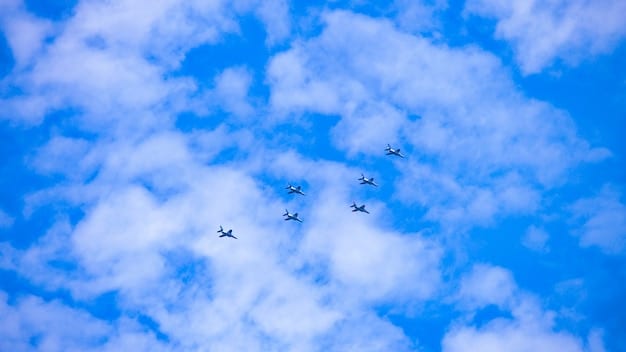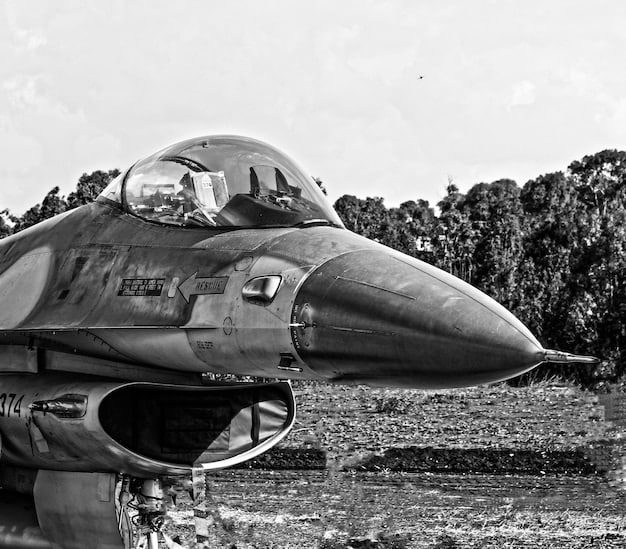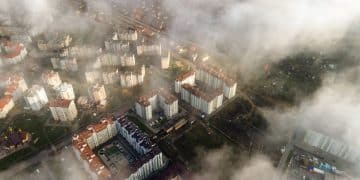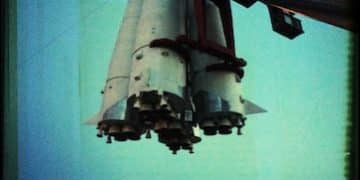The Korean War: Unpacking the Decisive Impact of Air Power on the Stalemate

During the Korean War, air power became a critical factor in shaping the conflict’s dynamics and contributing significantly to the eventual stalemate by providing crucial support to ground forces, interdicting enemy supply lines, and engaging in intense air-to-air combat.
The **Korean War: What Role Did Air Power Play in the Stalemate?** This question is central to understanding one of the most significant, yet often overshadowed, aspects of the conflict.
Origins of Air Warfare in Korea
Air power played a pivotal role in the Korean War, significantly impacting its trajectory and ultimate stalemate. Understanding its impact requires examining the origins of air warfare in the region and the initial strategies employed by both sides.
The Korean War, erupting in 1950, presented a new canvas for air power. The United States and its allies quickly realized the potential of aerial assets in supporting ground troops, interdicting enemy supply lines, and achieving air superiority.
Early Air Strategies and Objectives
Recognizing the strategic importance of controlling the skies, the US Air Force (USAF) and its allies prioritized gaining air superiority early in the conflict. This involved neutralizing North Korean air assets and establishing dominance over key areas.
- Initial engagements: Early missions focused on destroying North Korean airfields and aircraft to diminish their capacity to challenge allied air operations.
- Strategic bombing: The USAF initiated strategic bombing campaigns to target North Korean infrastructure, aiming to cripple their war-making capabilities.
- Close air support: Air assets provided critical close air support to ground forces, helping to repel enemy advances and protect vulnerable positions.
The initial phase of air warfare in Korea was characterized by a rapid escalation, with both sides recognizing the critical role air power would play in the overall conflict. As the war progressed, innovations in aircraft technology and tactics further shaped the landscape.

Key Aircraft and Technologies
The Korean War witnessed the introduction and widespread use of advanced aircraft and technologies that fundamentally changed aerial warfare. These advancements became instrumental in shaping the conflict’s dynamics.
The introduction of jet aircraft, such as the F-86 Sabre and the MiG-15, marked a significant leap in aerial combat capabilities. These aircraft engaged in fierce dogfights over “MiG Alley,” a region in North Korea known for intense air battles.
The F-86 Sabre vs. MiG-15
The aerial duels between the F-86 Sabre and the MiG-15 became legendary. The F-86, with its superior maneuverability and advanced radar, often held an edge, but the MiG-15’s high altitude capabilities and heavy armament made it a formidable adversary.
- F-86 Sabre: Renowned for its maneuverability and advanced radar systems, the F-86 provided allied forces with a crucial advantage in aerial combat.
- MiG-15: The MiG-15, known for its high altitude capabilities and substantial firepower, presented a significant challenge to the USAF.
- Technological advancements: The war spurred rapid advancements in aircraft design, radar technology, and air-to-air weaponry, enhancing the overall effectiveness of air operations.
The technological innovations during the Korean War dramatically impacted the effectiveness of air operations. They supported ground troops with precision strikes and disrupted enemy supply chains, leading to significant tactical advantages.
Strategic Bombing Campaigns
Strategic bombing campaigns constituted a major component of the air war strategy during the Korean War. These campaigns aimed to cripple North Korea’s ability to wage war by targeting critical infrastructure and industrial centers.
The USAF launched extensive bombing missions against North Korean targets, including factories, transportation networks, and command centers. These efforts sought to diminish the enemy’s war-making capacity and undermine their resolve.
Impact on North Korean Infrastructure
The relentless bombing campaigns resulted in widespread destruction across North Korea. Key infrastructure such as roads, bridges, and railways were severely damaged, disrupting supply lines and hindering the movement of troops and resources.
The bombing had a profound impact on North Korea’s ability to sustain its war efforts. The disruption of supply lines, coupled with the destruction of industrial centers, weakened the North Korean military.
- Targeting of infrastructure: Major roads, bridges, and railways were targeted, leading to significant disruptions in supply and troop movement.
- Impact on industrial centers: Bombing crippled key industrial facilities, further weakening North Korea’s capacity to produce and maintain war materials.
- Civilian impact: The extensive bombing campaigns resulted in substantial civilian casualties and widespread displacement, leading to a humanitarian crisis.
Close Air Support in Ground Battles
Close air support played a vital role in ground battles throughout the Korean War. Allied air assets provided critical support to ground troops, helping to repel enemy attacks, protect vulnerable positions, and shift the balance of power on the battlefield.
The effective coordination between air and ground forces became essential, allowing for swift and precise strikes against enemy targets. This support proved invaluable in numerous engagements.
Coordination and Effectiveness
The success of close air support hinged on effective communication and coordination between air and ground units. This coordination enabled accurate targeting, minimizing the risk of friendly fire and maximizing the impact on enemy forces.
- Communication protocols: Establishing reliable communication channels was essential for coordinating air strikes and ensuring accuracy.
- Forward air controllers: Forward air controllers (FACs) played a vital role, directing aircraft to specific targets and providing real-time feedback on the effectiveness of strikes.
- Impact on morale: The presence of air support boosted the morale of ground troops, knowing they could rely on aerial assistance in times of need.
Close air support provided not only direct tactical advantages but also psychological support to troops on the ground. This combination contributed significantly to maintaining defensive lines and mounting counter-offensives.

Air Interdiction and Supply Disruption
Air interdiction missions played a strategic role in the Korean War by targeting enemy supply lines and disrupting the flow of resources. These missions aimed to weaken the North Korean and Chinese forces by cutting off their access to essential supplies.
The USAF and allied air forces conducted numerous interdiction strikes against transportation networks, supply depots, and communication lines. These efforts sought to isolate enemy forces and limit their operational capabilities.
Impact on Enemy Logistics
The disruption of supply lines had a significant impact on the enemy’s ability to sustain operations. Reduced access to food, fuel, and ammunition weakened their combat effectiveness and morale.
- Targeting supply routes: Key supply routes, including roads, railways, and waterways, were targeted to disrupt the movement of resources.
- Disrupting logistics: Air interdiction missions destroyed supply depots, hindering the enemy’s ability to stockpile essential materials.
- Isolating enemy forces: By isolating units, air interdiction reduced the enemy’s overall combat effectiveness and forced them to operate with limited resources.
Air interdiction campaigns complemented strategic bombing missions by further weakening the enemy’s logistical backbone. This coordinated approach contributed significantly to the eventual stalemate by limiting North Korea’s and China’s capacity to sustain the war effort.
The Stalemate and Air Power’s Influence
The Korean War ultimately ended in a stalemate, with neither side achieving a decisive victory. Air power’s influence on this outcome is undeniable. By assessing the contributions and limitations, air power influenced the war’s inconclusive result.
Air power prevented a potential collapse by providing critical support to ground forces, disrupting enemy supply lines, and wearing down the enemy’s war-making capabilities, leading to the front lines settling near the 38th parallel.
Assessing Contributions and Limitations
Despite its significant contributions, air power also faced limitations during the Korean War. The rugged terrain, adverse weather conditions, and the enemy’s adaptive tactics presented numerous challenges. Additionally, the policies restricting strikes near the Yalu River, bordering China, constrained the full potential of air operations.
- Preventing collapse: Air support prevented ground forces from collapsing, enabling them to hold defensive lines and resist enemy advances.
- Disrupting enemy capabilities: Bombing missions curtailed enemy capabilities, hindering their ability to sustain effective operations.
- Limitations and challenges: Challenges like terrain, weather, and restrictive strike policies limited air power’s impact.
Without air power, the stalemate would not have been possible. By preventing a rout of the ground forces, the air actions played a critical role and influenced the final outcome of the Korean War.
| Key Point | Brief Description |
|---|---|
| ✈️ Air Superiority | Allied forces achieved air dominance early on. |
| 💣 Strategic Bombing | Infrastructure and industrial targets were heavily bombed. |
| 🛡️ Close Air Support | Airlines support help defend vulnerable positions. |
| 🚧 Air Interdiction | Attacks disrupted enemy supply and logistical routes. |
Frequently Asked Questions
▼
The main goals included achieving air superiority, providing close air support to ground forces, interdicting enemy supply lines, and strategically bombing key targets to weaken North Korea’s war-making capabilities.
▼
The F-86 Sabre was crucial for attaining air dominance. Its superior maneuverability and advanced radar gave allied forces a strategic upper hand in aerial combats.
▼
It caused widespread destruction, targeting North Korea’s infrastructure and industrial centers. This led to significant disruptions in supply lines, weakening war capabilities and impacting the morale.
▼
Close air support provided critical assistance, enabling troops to repel attacks and protect vulnerable positions. Effective coordination and reliable channels were key to success, maximizing the impact on enemy forces.
▼
Air interdiction targeted supply and transportation networks, disrupting the movement of crucial resources. This strategy isolated and weakened enemy forces by limiting their access to food, fuel, ammunition, and other supplies.
Conclusion
In summary, air power’s multifaceted role – from gaining air superiority and conducting strategic bombing to providing close air support and disrupting enemy supply lines – significantly influenced the Korean War’s dynamics and its ultimate stalemate. Air power ensured that despite facing numerous challenges, the front lines stabilized, fundamentally influencing the non-decisive outcome of the conflict.





